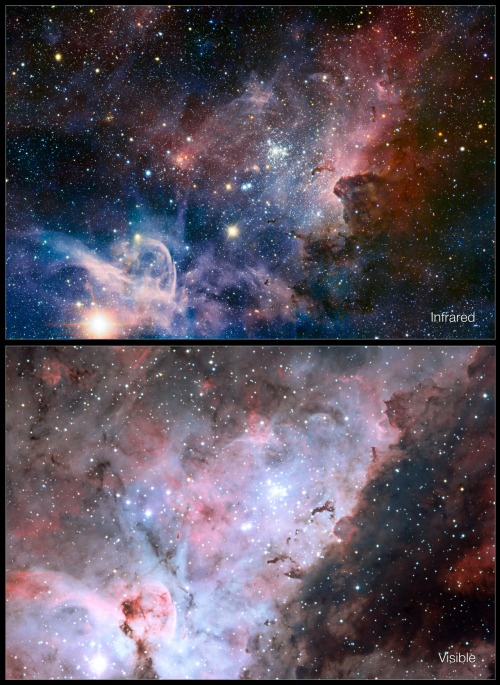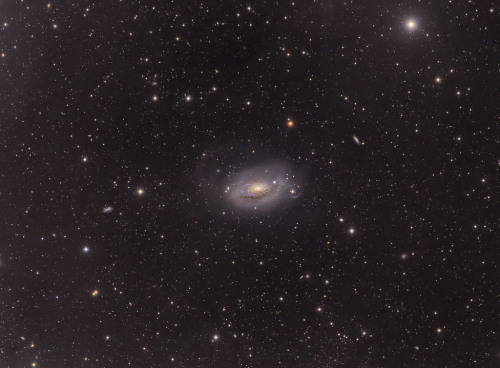Littlecadet-biguniverse - Space, Our Favorite Frontier!!

More Posts from Littlecadet-biguniverse and Others

NASA Astronomy Picture of the Day 2016 August 31
Annular Solar Eclipse over New Mexico
What is this person doing? In 2012 an annular eclipse of the Sun was visible over a narrow path that crossed the northern Pacific Ocean and several western US states. In an annular solar eclipse, the Moon is too far from the Earth to block out the entire Sun, leaving the Sun peeking out over the Moon’s disk in a ring of fire. To capture this unusual solar event, an industrious photographer drove from Arizona to New Mexico to find just the right vista. After setting up and just as the eclipsed Sun was setting over a ridge about 0.5 kilometers away, a person unknowingly walked right into the shot. Although grateful for the unexpected human element, the photographer never learned the identity of the silhouetted interloper. It appears likely, though, that the person is holding a circular device that would enable them to get their own view of the eclipse. The shot was taken at sunset on 2012 May 20 at 7:36 pm local time from a park near Albuquerque, New Mexico, USA. Tomorrow another annular solar eclipse will become visible, this time along a path crossing Africa and Madagascar.

Three LEGO Minifigures Journey to Jupiter
Did you know that the Juno mission is also one giant leap for minifigure-kind? Three LEGO crew members have set their sights on being the first toy to visit another planet, enduring the five year, 1.75 billion mile journey aboard NASA’s Juno spacecraft. One minifigure is a likeness of Galileo Galilei – who discovered Jupiter’s four largest moons. The other two represent the Roman god Jupiter and his wife Juno. Each figure has been custom molded out of aluminum to represent their special characteristics. Jupiter carries a lightning bolt, Juno has a magnifying glass to represent her search for truth, Galileo is carrying a telescope and a model of the planet Jupiter.
To me, these minifigures add a beautifully ordinary and intensely human element to this extraordinary mission.
Explore more of the LEGO Group’s partnership with NASA at LEGO.com/Space

The Milky Way was so very alive this weekend in the backcountry.. Hope you all had a chance to look up and watch the cosmos whiz by.. #stars #nightphotography #nightsky #darksky #adventure

Infrared/visible-light comparison of the Carina Nebula
js


Jupiter’s North Pole Unlike Anything Encountered in Solar System
NASA’s Juno spacecraft has sent back the first-ever images of Jupiter’s north pole, taken during the spacecraft’s first flyby of the planet with its instruments switched on. The images show storm systems and weather activity unlike anything previously seen on any of our solar system’s gas-giant planets. “First glimpse of Jupiter’s north pole, and it looks like nothing we have seen or imagined before,” said Scott Bolton, principal investigator of Juno from the Southwest Research Institute in San Antonio. “It’s bluer in color up there than other parts of the planet, and there are a lot of storms. There is no sign of the latitudinal bands or zone and belts that we are used to – this image is hardly recognizable as Jupiter. We’re seeing signs that the clouds have shadows, possibly indicating that the clouds are at a higher altitude than other features.”
Credit: NASA/JPL-Caltech/SwRI/MSSS

Rho Ophiuchi

M63 // Sunflower Galaxy

Andromeda, Our Sister Galaxy
'Enterprise' Nebulae Seen by Spitzer
NASA - Spitzer Space Telescope patch. Sept. 8, 2016
Image above: These nebulae seen by NASA’s Spitzer Space Telescope, at left, may resemble two versions of the starship Enterprise from “Star Trek,” overlaid at right. Image Credits: NASA/JPL-Caltech. Just in time for the 50th anniversary of the TV series “Star Trek,” which first aired September 8th,1966, a new infrared image from NASA’s Spitzer Space Telescope may remind fans of the historic show. Since ancient times, people have imagined familiar objects when gazing at the heavens. There are many examples of this phenomenon, known as pareidolia, including the constellations and the well-known nebulae named Ant, Stingray and Hourglass. On the right of the image, with a little scrutiny, you may see hints of the saucer and hull of the original USS Enterprise, captained by James T. Kirk, as if it were emerging from a dark nebula. To the left, its “Next Generation” successor, Jean-Luc Picard’s Enterprise-D, flies off in the opposite direction. Astronomically speaking, the region pictured in the image falls within the disk of our Milky Way galaxy and displays two regions of star formation hidden behind a haze of dust when viewed in visible light. Spitzer’s ability to peer deeper into dust clouds has revealed a myriad of stellar birthplaces like these, which are officially known only by their catalog numbers, IRAS 19340+2016 and IRAS19343+2026. Trekkies, however, may prefer using the more familiar designations NCC-1701 and NCC-1701-D. Fifty years after its inception, Star Trek still inspires fans and astronomers alike to boldly explore where no one has gone before.
Spitzer Space Telescope. Image Credits: NASA/JPL-Caltech
This image was assembled using data from Spitzer’s biggest surveys of the Milky Way, called GLIMPSE and MIPSGAL. Light with a wavelength of 3.5 microns is shown in blue, 8.0 microns in green, and 24 microns in red. The green colors highlight organic molecules in the dust clouds, illuminated by starlight. Red colors are related to thermal radiation emitted from the very hottest areas of dust. JPL manages the Spitzer Space Telescope mission for NASA’s Science Mission Directorate, Washington. Science operations are conducted at the Spitzer Science Center at Caltech in Pasadena, California. Spacecraft operations are based at Lockheed Martin Space Systems Company, Littleton, Colorado. Data are archived at the Infrared Science Archive housed at the Infrared Processing and Analysis Center at Caltech. Caltech manages JPL for NASA. For more information about Spitzer, visit: http://spitzer.caltech.edu http://www.nasa.gov/spitzer Images (mentioned), Text, Credits: NASA/Tony Greicius/JPL/Elizabeth Landau/Written by Robert Hurt, NASA’s Spitzer Science Center. Greetings, Orbiter.ch Full article
Solar System: Things to Know This Week
Our solar system is huge, so let us break it down for you. Here are a few things to know this week:
1. We’re Going In

To be honest, Jupiter is kind of a monster. Not only is it the biggest planet in the solar system, but it also wields the most dangerous radiation and other powerful forces. Despite the risks, our Juno probe is going in close, because Jupiter also holds precious clues to how the planets formed, including our own. Arrival date: July 4. Watch the Juno mission trailer video HERE.
2. Moon Maps

The moon is beautiful in the sky, and also up close—sometimes even in the maps that scientists use to study its surface. Here are some evocative maps that lunar geologists have drawn up to chart the landscapes in the moon’s dramatic Tycho Crater. Take a look HERE.
3. That’s No Moon…Sort Of

The full moon we’ll see this week is not Earth’s only companion in space. Astronomers have discovered a small asteroid in an orbit around the sun that keeps it near the Earth, where it will remain for centuries. But it’s not exactly a second moon, either.
4. Power Blast

Venus has an “electric wind” strong enough to remove the components of water from its upper atmosphere, which may have played a significant role in stripping Earth’s twin planet of its oceans, according to new results from the European Space Agency (ESA) Venus Express mission by NASA-funded researchers.
5. How Green (Well, Red) Was My Valley

“Marathon Valley” slices through the rim of a large crater on Mars. It has provided fruitful research targets for our Opportunity rover since July 2015, but now the rover’s team is preparing to move on.
Want to learn more? Read our full list of the 10 things to know this week about the solar system HERE.
Make sure to follow us on Tumblr for your regular dose of space: http://nasa.tumblr.com
-
 batsratsandalleycats reblogged this · 5 years ago
batsratsandalleycats reblogged this · 5 years ago -
 batsratsandalleycats liked this · 5 years ago
batsratsandalleycats liked this · 5 years ago -
 restroom liked this · 5 years ago
restroom liked this · 5 years ago -
 okelito27 liked this · 7 years ago
okelito27 liked this · 7 years ago -
 cuore00solitario liked this · 7 years ago
cuore00solitario liked this · 7 years ago -
 ahandfulofhope liked this · 7 years ago
ahandfulofhope liked this · 7 years ago -
 respectful-rebel reblogged this · 7 years ago
respectful-rebel reblogged this · 7 years ago -
 lavender-bpd reblogged this · 7 years ago
lavender-bpd reblogged this · 7 years ago -
 cherub-bf liked this · 7 years ago
cherub-bf liked this · 7 years ago -
 youremyalways reblogged this · 7 years ago
youremyalways reblogged this · 7 years ago -
 the-stars-begin-to-fall reblogged this · 7 years ago
the-stars-begin-to-fall reblogged this · 7 years ago -
 youremyalways liked this · 7 years ago
youremyalways liked this · 7 years ago -
 99-s-anxious-lady liked this · 7 years ago
99-s-anxious-lady liked this · 7 years ago -
 more-things-in-heavenandearth reblogged this · 7 years ago
more-things-in-heavenandearth reblogged this · 7 years ago -
 highlightsofeverything reblogged this · 7 years ago
highlightsofeverything reblogged this · 7 years ago -
 highlightsofeverything liked this · 7 years ago
highlightsofeverything liked this · 7 years ago -
 bambiwaralki reblogged this · 7 years ago
bambiwaralki reblogged this · 7 years ago -
 chibi-devil reblogged this · 7 years ago
chibi-devil reblogged this · 7 years ago -
 knivesandstars reblogged this · 7 years ago
knivesandstars reblogged this · 7 years ago -
 starynighty reblogged this · 7 years ago
starynighty reblogged this · 7 years ago -
 starynighty liked this · 7 years ago
starynighty liked this · 7 years ago -
 ouranien reblogged this · 7 years ago
ouranien reblogged this · 7 years ago -
 josamarau liked this · 7 years ago
josamarau liked this · 7 years ago -
 nebulitshop-blog reblogged this · 7 years ago
nebulitshop-blog reblogged this · 7 years ago -
 god-ex liked this · 7 years ago
god-ex liked this · 7 years ago -
 ixtasneem-blog liked this · 7 years ago
ixtasneem-blog liked this · 7 years ago -
 powered-by-alpaca-blog liked this · 8 years ago
powered-by-alpaca-blog liked this · 8 years ago -
 penelopethehufflepuffbiatch reblogged this · 8 years ago
penelopethehufflepuffbiatch reblogged this · 8 years ago -
 penelopethehufflepuffbiatch liked this · 8 years ago
penelopethehufflepuffbiatch liked this · 8 years ago -
 bsowjdlabdlsbd reblogged this · 8 years ago
bsowjdlabdlsbd reblogged this · 8 years ago -
 mysticalpariah-blog liked this · 8 years ago
mysticalpariah-blog liked this · 8 years ago -
 beazhoney7777rm37-blog liked this · 8 years ago
beazhoney7777rm37-blog liked this · 8 years ago -
 nocturnaldistress reblogged this · 8 years ago
nocturnaldistress reblogged this · 8 years ago -
 icantputmyfingeronit reblogged this · 8 years ago
icantputmyfingeronit reblogged this · 8 years ago -
 cukierbender-blog liked this · 8 years ago
cukierbender-blog liked this · 8 years ago -
 lorenabianchi reblogged this · 8 years ago
lorenabianchi reblogged this · 8 years ago -
 revatron reblogged this · 8 years ago
revatron reblogged this · 8 years ago -
 tillthemoonandthestarscollide reblogged this · 8 years ago
tillthemoonandthestarscollide reblogged this · 8 years ago
GREETINGS FROM EARTH! Welcome to my space blog! Let's explore the stars together!!!
144 posts